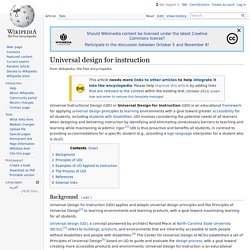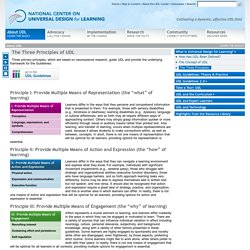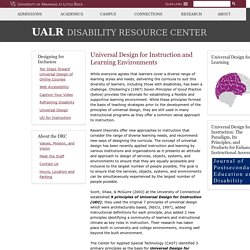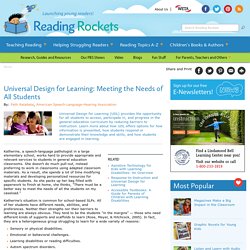

Universal Design of Instruction (UDI): Definition, Principles, Guidelines, and Examples. Pre-college and college students come from a variety of ethnic and racial backgrounds.

For some, English is not their first language. Also represented in most classes are students with a diversity of ages and learning styles, including visual and auditory. In addition, increasing numbers of students with disabilities are included in regular pre-college and post-secondary courses. Their disabilities include blindness, low vision, hearing impairments, mobility impairments, learning disabilities, and health impairments. Universal design for instruction. Universal Instructional Design (UID) or Universal Design for Instruction (UDI) is an educational framework for applying universal design principles to learning environments with a goal toward greater accessibility for all students, including students with disabilities.

UDI involves considering the potential needs of all learners when designing and delivering instruction by identifying and eliminating unnecessary barriers to teaching and learning while maintaining academic rigor.[1] UDI is thus proactive and benefits all students, in contrast to providing accommodations for a specific student (e.g., providing a sign language interpreter for a student who is deaf). Background[edit] Equal Access: Universal Design of Instruction. 2_TEAL_UDL.pdf. Understanding Universal Design in the Classroom. By Alexa Darby, Elon University.

The Three Principles. Three primary principles, which are based on neuroscience research, guide UDL and provide the underlying framework for the Guidelines: Principle I: Provide Multiple Means of Representation (the “what” of learning) Learners differ in the ways that they perceive and comprehend information that is presented to them.

For example, those with sensory disabilities (e.g., blindness or deafness); learning disabilities (e.g., dyslexia); language or cultural differences, and so forth may all require different ways of approaching content. Others may simply grasp information quicker or more efficiently through visual or auditory means rather than printed text. [Universal Design for Instruction in Postsecondary Education] Universal Design for Instruction (UDI) is an approach to teaching that consists of the proactive design and use of inclusive instructional strategies that benefit a broad range of learners including students with disabilities.
![[Universal Design for Instruction in Postsecondary Education]](http://cdn.pearltrees.com/s/pic/th/instruction-postsecondary-125521158)
The nine Principles of UDI© provide a framework for college faculty to use when designing or revising instruction to be responsive to diverse student learners and to minimize the need for "special" accommodations and retrofitted changes to the learning environment. UDI operates on the premise that the planning and delivery of instruction, as well as the evaluation of learning can incorporate inclusive attributes that embrace diversity in learners without compromising academic standards.
Adapted From: ADA: Fast Facts for Faculty - Universal Design. Elements of Good Teaching Universal Design Definition: Universal design is an approach to designing course instruction, materials, and content to benefit people of all learning styles without adaptation or retrofitting.

Universal design provides equal access to learning, not simply equal access to information. Universal Design allows the student to control the method of accessing information while the teacher monitors the learning process and initiates any beneficial methods. Although this design enables the student to be self-sufficient, the teacher is responsible for imparting knowledge and facilitating the learning process. Who Benefits: Students who speak English as a second language. Universal Design for Instruction and Learning Environments - Disability Resource Center. While everyone agrees that learners cover a diverse range of learning styles and needs, delivering the curricula to suit this diversity of learners, including those with disabilities, has been a challenge.

Chickering’s (1987) Seven Principles of Good Practice (below) provides the rationale for establishing a flexible and supportive learning environment. While these principles formed the basis of teaching strategies prior to the development of the principles of universal design, they are still used in many instructional programs as they offer a common sense approach to instruction.
Recent theorists offer new approaches to instruction that consider the range of diverse learning needs, and recommend new ways of designing the curricula. Universal Design - Disability Resource Center. Universal design is a concept that has emerged from the architectural field and is now being applied in other arenas such as instruction.

The term “universal design” was defined by the team of architects, environmental researchers, engineers and product designers who are credited with its origin. They define universal design as “the design of products and environments to be usable by all people, to the greatest extent possible, without the need for adaptation or specialized design.” This same team of professionals developed a set of seven principles which guide designers in the development of products and environments to maximize usability and accessibility. Universal Design of Instruction (UDI) - Accessibilty - Wayne State University. Universal Design of Instruction is an approach to teaching that consists of the proactive design of instruction, materials and content, as well as the use of inclusive strategies that benefit a broad range of learners, including students with disabilities.

UDI provides equal access to learning, not simply equal access to information. UDI is based on the concept of universal design — an idea that originated in the field of architecture to meet the needs of an increasingly diverse public. Today's college student population is increasingly diverse in educational background, age, gender, culture, ability, disability and primary language. Faculty who are designing instructional experiences and supportive learning environments have an opportunity to enhance instructional accessibility and usability.
Universal Design for Learning: Meeting the Needs of All Students. Katherine, a speech-language pathologist in a large elementary school, works hard to provide appropriate and relevant services to students in general education classrooms.

She doesn't do much pull-out, instead preferring to work in classrooms using adapted classroom materials. As a result, she spends a lot of time modifying materials and developing personalized resources for specific students. As she packs up her bag filled with paperwork to finish at home, she thinks, "There must be a better way to meet the needs of all the students on my caseload. " Katherine's situation is common for school-based SLPs. About UDL. A short video by CAST illustrates the three principles of Universal Design for Learning. How US Federal Statute Defines UDL The Higher Education Opportunity Act (HEOA) of 2008, passed with strong bipartisan support, established the statutory definition for universal design for learning. Read the definition UDL Series A free online collection of rich media presentations that help educators to build UDL understanding, implementa-tion skills, and leadership ability.
Visit the UDL Series. UDL Guidelines 2.0. The goal of education in the 21st century is not simply the mastery of content knowledge or use of new technologies. It is the mastery of the learning process. Education should help turn novice learners into expert learners—individuals who want to learn, who know how to learn strategically, and who, in their own highly individual and flexible ways, are well prepared for a lifetime of learning. Universal Design for Learning (UDL) helps educators meet this goal by providing a framework for understanding how to create curricula that meets the needs of all learners from the start.
The UDL Guidelines, an articulation of the UDL framework, can assist anyone who plans lessons/units of study or develops curricula (goals, methods, materials, and assessments) to reduce barriers, as well as optimize levels of challenge and support, to meet the needs of all learners from the start. They can also help educators identify the barriers found in existing curricula.
Learn more about the UDL Guidelines: What is Universal Design for Learning. Universal Design for Learningis a set of principles for curriculum development that give all individuals equal opportunities to learn. UDL provides a blueprint for creating instructional goals, methods, materials, and assessments that work for everyone--not a single, one-size-fits-all solution but rather flexible approaches that can be customized and adjusted for individual needs. Why is UDL necessary? Individuals bring a huge variety of skills, needs, and interests to learning. Neuroscience reveals that these differences are as varied and unique as our DNA or fingerprints. Three primary brain networks come into play: Recognition Networks. Universal Design for Learning. Universal Design for Learning (UDL) is an educational framework based on research in the learning sciences, including cognitive neuroscience, that guides the development of flexible learning environments and learning spaces that can accommodate individual learning differences.[1] Universal Design for learning is a set of principles that allow teachers with a structure to develop instructions to meet the diverse needs of all learners.
Recognizing that the way individuals learn can be unique, the UDL framework, first defined by David H. Rose, Ed.D. of the Harvard Graduate School of Education and the Center for Applied Special Technology (CAST) in the 1990s,[2] calls for creating curriculum from the outset that provides: Origins[edit] UDL Examples and Resources. Disclaimer: The examples and resources highlighted on these pages have been gathered for educational purposes. CAST does not necessarily endorse the products listed, nor does their inclusion here mean that these products are complete expressions of the UDL principles and guidelines. They may illustrate certain principles and not others. Below, you will find teacher-friendly examples and resources that illustrate each of the UDL checkpoints. Exploring these examples and resources not only helps to clarify what is meant by each of the checkpoints but also gives teachers ideas of ways to implement UDL in their classrooms.
These lists are meant to be a sampling of the different examples and resources that are available. We're on Diigo! Want to search our examples and resources? Never used Diigo before? Principle I. UDL Guidelines: Theory & Practice Version. This is an alternate version of the UDL Guidelines found in the new book UDL Theory and Practice. The principles, guidelines and research basis are the same, however the order of the principles and the guidelines have changed.
Provide Multiple Means ofEngagementPurposeful, motivated learners Provide options for self-regulation+ Promote expectations and beliefs that optimize motivation+ Facilitate personal coping skills and strategies+ Develop self-assessment and reflection. CAST UDL Lesson Builder.
UDL On Campus: About UDL. (music) [Title: UDL On Campus, Gabrielle Rappolt-Schlichtmann, Co-President of CAST, appears on the screen.] GABRIELLE RAPPOLT-SCLICTHMANN: Learning is really a lifelong journey and when students come to postsecondary they're incredibly diverse. What Is Universal Design for Learning? About CAST. About Universal Design for Learning.